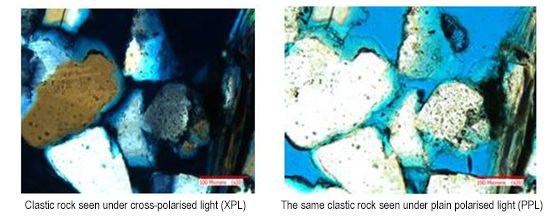Conwy Valley Systems
PETROG™ Petrography Product Uses PL-D734CU and M5B Cameras
Conwy Valley Systems Limited is a group of companies that specialize in servicing the geoscience industry. Their flagship product PETROG, an integrated petrographic data collection, storage and analysis system, was developed to service the highly specialized field of petrography, which requires looking at a rock under a microscope and describing its structure. Generally, a section is taken through a rock and ground down to a thickness of about 30 microns, which is thin enough for light to pass through.
Petrographers are identifying rock composition and texture in order to make decisions on prospectivity, structural stability, provenance or feed ratio and speed, in respective to oil & gas, concrete, archaeology and iron & steel applications.
A petrographer's input is critical. This is not a task that can as yet be undertaken by a computer, neither from analysis of light microscope images nor by using sophisticated SEM (Scanning Electron Microscopy). SEM can quantify the amount of each chemically distinct component, but only the human eye can, at present, identify the habit, morphology and hence history, each of which typically will vary within each component.
The field of petrography is so specialized there is almost no overlap between petrographers specialising in clastic sedimentary rocks (clastic rocks are formed mainly of particles of other rocks) and those specialising in carbonate sedimentary rocks (rocks formed from carbonates, mainly limestone and dolostone).
The primary tool of thin section petrography is point counting. A rock is described in great detail at a number of representative or random points and then statistical techniques are used to analyse the results. Point counting requires a large number of points to be described in order to form a statistically valid description of the whole slide. The number of points will vary with the type of material and degree of confidence required, and hence the purpose to which the analysis will be put. A study of an oil-bearing rock may only require 400 points per slide, whereas a safety-critical concrete structure would typically be described at 1000 points.
Dr. Barrie Wells, Product Manager/Programmer, with Conwy Valley Systems Limited, is an information management consultant with 33 years of technical & project management experience in the mining and oil exploration industries world-wide. In looking for a camera solution to seamlessly integrate with PETROG, Dr. Wells selected the Pixelink PL-D734CU and M5B camera models.
“Camera choice is in some ways different for petrography,” said Dr. Wells. “High resolution is not generally important, because for the point counting itself, only the point at the centre (under the microscope's cross-hairs) is relevant. Colour consistency is crucial, as colour can be diagnostic for certain minerals. Image refresh speed is also vital as is dynamic range. Images can have quite high contrast, but some rocks have far greater contrast between almost opaque minerals and almost transparent. Capturing several images at different illumination levels is possible but not as convenient as the camera being able to capture a higher range. With all these criteria we needed a solid and reliable camera. Pixelink offers a great line of products and their support has been outstanding.”
